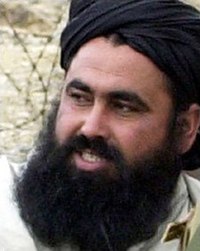
Back بيت الله محسود Arabic Bayatulla Məshud Azerbaijani বায়তুল্লাহ মেহসুদ Bengali/Bangla Baitullah Mehsud German Baitullah Mehsud Spanish Baitullah Mehsud Estonian بیتالله محسود Persian Baitullah Mehsud Finnish Baitullah Mehsud French בייטוללה מחסוד HE
Baitullah Mehsud | |
|---|---|
بیت اللہ محسود | |
 | |
| Founder and 1st Emir of Tehrik-i-Taliban Pakistan | |
| In office December 2007 – 5 August 2009 | |
| Preceded by | Position created |
| Succeeded by | Hakimullah Mehsud |
| Personal details | |
| Born | c. 1970 Bannu District, Khyber Pakhtunkhwa, Pakistan |
| Died | 5 August 2009 (aged 38–39) South Waziristan, Khyber Paktunkhwa, Pakistan |
| Cause of death | U.S. drone strike |
| Military service | |
| Allegiance | |
| Years of service | 2000s–2009 |
| Rank | Emir of Tehrik-e-Taliban Pakistan |
| Battles/wars | |
Baitullah Mehsud (Pashto/Urdu: بیت اللہ محسود; c. 1970 – 5 August 2009)[1][2][3] was one of the founders and a leading member of the TTP in Waziristan, Pakistan, and the leader of the Tehrik-e-Taliban Pakistan (TTP). He formed the TTP from an alliance of about five militant groups in December 2007.[4][5][6] He is thought by U.S. military analysts to have commanded up to 5,000 fighters[4] and to have been behind numerous attacks in Pakistan[5] including the assassination of Benazir Bhutto which he and others have denied.
Disagreement exists over the exact date of the militant's death. Pakistani security officials initially announced that Baitullah Mehsud and his wife were killed on 5 August 2009 in a U.S. Central Intelligence Agency drone attack in the Zangar area of South Waziristan. Interior Minister Rehman Malik delayed giving official confirmation and asked for patience and an announcement by Inter Services Public Relations (ISPR) or other agencies. Kafayat Ullah, a TTP source, also announced the death of the militant in the strike,[7] as did his deputy Faqir Mohammed.[8] Later Tehrik-i-Taliban Pakistan commander Hakimullah Mehsud denied previous TTP announcements and said Mehsud was in good health.[9] Major General Athar Abbas, ISPR spokesman, and Robert Gibbs of the White House said his death could not be confirmed,[10][11] U.S. National Security Adviser James L. Jones also claimed that there was "pretty conclusive" evidence that proved Baitullah Mehsud had been killed and that he was 90% sure of it.[12] On 23 August 2009, Hakimullah Mehsud and Wali-ur-Rehman telephoned the BBC to say that Baitullah Mehsud had died on 23 August 2009 due to injuries sustained during the 5 August attack.[1] On 30 September 2009, the BBC received a video that showed the body of Mehsud.[13]
Syed Saleem Shahzad, writing in the Asia Times, described Baitullah Mehsud as a physically small man, with diabetes.[14]
- ^ a b "Taliban admit commander's death". BBC. 25 August 2009. Retrieved 25 August 2009.
- ^ Ayaz Gul (6 August 2009). "Pakistan Foreign Minister: Taliban Chief Baitullah Mehsud is Dead". Voice of America. Islamabad. Archived from the original on 7 August 2009. Retrieved 7 August 2009.
- ^ Hamid Shalizi; Peter Graff; Jeremy Laurence (7 August 2009). "Afghan Taliban say unhurt by Mehsud death". Reuters. Kabul. Retrieved 7 August 2009.
- ^ a b Tighe, Paul & Katz, Ian (10 August 2009). "Pakistan Challenges Taliban to Show Leader Mehsud Still Alive". Bloomberg L.P. Archived from the original on 20 July 2012. Retrieved 9 August 2009.
- ^ a b Masood, Salman (26 February 2008). "Blast Kills Surgeon General of Pakistani Army". The New York Times. Archived from the original on 24 May 2013. Retrieved 26 August 2008.
- ^ Abbas, Hassan."A Profile of Tehrik-i-Taliban Pakistan Archived 9 April 2016 at the Wayback Machine". CTC Sentinel 1 (2): 1–4. January 2008.
- ^ "Aide says Pakistani Taliban leader Mehsud is dead". Associated Press. 7 August 2009. Archived from the original on 10 August 2009. Retrieved 7 August 2009.
- ^ Pakistan: Taliban Leader Baitullah Mehsud Is Dead, Militant Group Commander Says|World News|Sky News Archived 9 August 2009 at the Wayback Machine
- ^ "Pakistan Taliban denies leader dead". Aljazeera. 8 August 2009. Archived from the original on 8 August 2009. Retrieved 7 August 2009.
- ^ "ISPR denies reports of Mehsud killing". Malayasia Sun. Midwest Radio Network. 7 August 2009. Archived from the original on 18 September 2009. Retrieved 7 August 2009.
- ^ "White House declines to confirm death of Taliban chief in Pakistan". Xinhua. 8 August 2009. Archived from the original on 12 August 2009. Retrieved 7 August 2009.
- ^ Subler, Jason; Graham, Patrick & Haider, Kamran (9 August 2009). "UPDATE 3-US says evidence Taliban chief dead "pretty conclusive"". Reuters. Thomson Reuters. Archived from the original on 10 August 2009. Retrieved 9 August 2009.
- ^ "Taliban film shows leader is dead". BBC. 30 September 2009. Retrieved 26 April 2010.
- ^ Syed Saleem Shahzad (8 August 2009). "Baitullah: Dead or alive, his battle rages". Asia Times. Archived from the original on 10 August 2009. Retrieved 7 August 2009.
Over the past few years, the small, diabetic yet hugely charismatic Baitullah has established himself and his TTP, a militant umbrella group primarily in conflict with the central government, in South Waziristan and beyond. Many view him as a bigger threat than al-Qaeda leader Osama bin Laden.
{{cite news}}: CS1 maint: unfit URL (link)